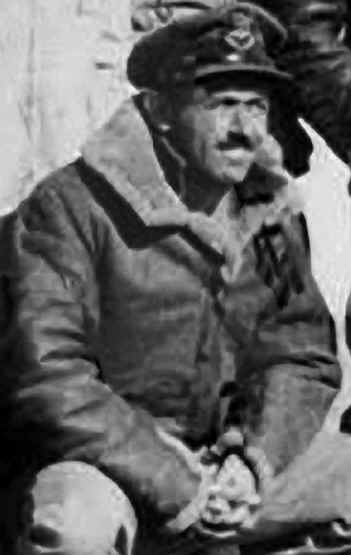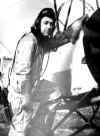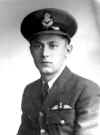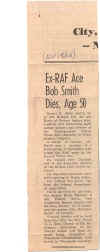I encourage anyone that has more information (Flight Log Book entries) or photos on 112 Squadron please send an e-mail to [email protected] before the history is lost.
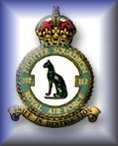
Internet Finds of RAF 112 Sqn Personnel
R to
SThe Americans, New Zealanders, The Polish
Dentist ‘Fangs Redfern, wing dentist had a small hospital at Jesi and the wing‘ also set up his
stall with us.at 112 Sqn
Flying Officer
Albert Melville Ross, 40142, RAF, 16/5/39 to 9/12/1940went to 274 Sqdn KIA 20/5/41
Photo supplied by Patricia Malloy daughter of J. F. Fraser
Flying
Officer Anthony
Gray-Worcester of 112 Squadron, was killed on 18 July while leading a
formation down through cloud. He was probably flying Gladiator K6130, which was
lost during the day when it hit a hill obscured by a cloud at Qaret el Naga.
Flying Officer Albert. Melville. Ross became temporary "A" Flight
Commander until the arrival of Flight Lieutenant Schwab, who arrived on 23 July
1940
Photos of FL/LT EDWARD ROSS 'A' COMMANDER
donated from the collection of his son Alistair Ross

1
12 Sqn Pilots E.ROSS, 115030, standing on truck right hand side (hand on hip) wearing forage cap112 Sqn PilotsE.ROSS, 115030, standing on truck right hand side (hand on hip) wearing forage cap.
WO WD Brown believed to be far right with holster
FL/LT EDWARD ROSS 'A' COMMANDER. FX740 OF NO 112 SHARK Squadron Cutella Italy 1944. This aircraft was the personal mount of my late father He originated the '?' on his aircraft FX 561, FX740 and FX760 .FX 740 HAS OVER THE YEARS , BEEN WRONGLY CREDITED TO SGT PILOT DAVIES WHO WAS KILLED ON 31MAY'44.My father was a very experienced fighter-bomber pilot who flew over 134 combat missions with the Sharks from North Africa through to Malta, Sicily and on to the invasion of Italy. I would gladly send you an extract from his log book to verify this. The '?' he originated on his aircraft Fx 561/740/760 was to commemorate " Here today ,gone tomorrow" reflecting the high attrition rate that the planes and men of 112 faced in Italy at this time . Best wishes Alistair Ross Further Research shows Sgt G F Davis having been shot down in FX740 GA ? on 31 May 1944 see Planes Lost 1940-45 page
This note from Robert "Jock" Sinclair 23 Sept 2007,
FL/LT EDWARD ROSS 'A' COMMANDER, normally flew FX561 coded GA-R, on the 7th of May he changed the "R" to "?" and continued to fly "?" and other aircraft sometimes doing 2-3 sorties in a day. On the 26 May 1944 he flew FX740, GA"?" and continued to fly this aircraft until tour expired, three days later on 29 May 1944, During the month of May he flew 26 sorties.
Sgt George Fredrick DAVIS, Joined RAF 112 Sqdn on 1 May 1944, from 239 Wing Training Flight. He commenced flying operationally 2 May 1944, with 2 sorties that day.On the month of May he flew 22 sorties, 21 on aircraft of various symbols. He only flew one sortie on FX740 "?" on 31 May 1944. He was shot down and killed by intense and accurate Breda fire on a low level strafing run.
FX760
"?" the replacement for FX740 "?" was flown by Flt/Lt Reginald Albert Wild, DFC, 407884, RAAF, regularly until it
was exchanged for the Mustang Mk III, on 23 June 1944.
Flt/Lt Reginald Albert Wild, joined RAF 112 Sqdn on 1 June 1944 on
his 2nd tour of duty. Flying practice commenced on Mustangs and continued until
the first operational flights took place on 5 July 1944.
Flt Sgt A.G. Rowe
Plt Off G.W. Rutherford J.16548 RCAf
*************************************************
Plt Off J. H. "Doom" Sanderson, 39189, RAF, 16/5/39 to 31/8/40
Photo supplied by Patricia Molloy daughter of J. F. Fraser
Flt Lt Kenneth Howard "Pete" Savage, 37483 RAF, 16/5/39 to 06/11/1940, KIA
Photo supplied by Patricia Molloy daughter of J. F. Fraser
SABOURIN, F/L Joseph Jean Paul (J3519)
#1 Taken 1942, #2 Under pilot training, No.1 Elementary Flying Training School, #3 Just before posting overseas.
Son of Leon-Xiste Sabourin and Amelia Sabourin,
- of St. Isidore de Prescott, Ontario, Cannada.
Born at St. Isidore de Prescott, Ontario, 8 Jan. 1915
B.A. (Ottawa University).
Enlisted in Ottawa, 4 June 1940.
Trained at No.1 ITS,
No.1 EFTS, and
No.1 SFTS;
wings 12 December 1940.
Arrived in UK, 2 March 1941.
Further trained at No.57 OTU, March to May 1941.
With No.145 Squadron, 5 May to 30 October 1941.
With No.112 Sq., N. Africa, 12 Nov '41 to 28 Dec '41
(Shot down Nov. 22, 1941)
On non-operational duties until May 1942.
No.145 Squadron, 18 May to
16 September 1942 (KIA - 27 years old) shot down
by Uffz Von Arnswald of the
III./JG 27
Award presented by Governor General
to next-of-kin, 17 April 1943.
http://www.airforce.ca/wwii/ALPHA-SA.html
- Distinguished Flying Cross - No.145 Squadron - Award effective 28 September 1942 as per London Gazette
dated 6 October 1942 and AFRO 1653/42 dated 16 October 1942. Born at St. Isidore de Prescott, Ontario,
8 January 1915. Enlisted in Ottawa, 4 June 1940. Trained at No.1 ITS, No.1 EFTS, and No.1 SFTS; wings
12 December 1940. Arrived in UK, 2 March 1941. Further trained at No.57 OTU, March to May 1941. With
No.145 Squadron, 5 May to 30 October 1941. With No.112 Squadron, North Africa, 12 November 1941 to
28 December 1941. On non-operational duties until May 1942. No.145 Squadron, 18 May to 16 September
1942 (killed in action). Award presented by Governor General to next-of-kin, 17 April 1943. Aerial victories as
follows: 5 December 1941, one G.50, one Ju.87 and one Bf.109 destroyed plus two Bf.109s and one G.50
damaged (Tomahawk AK457); 8 June 1942, one Bf.109 destroyed (shared with another pilot; this was the first
Spitfire victory in North Africa); 12 June 1942, one Bf.109 destroyed; 8 September 1942, one Bf.109 destroyed;
16 September 1942, one Bf.109 destroyed. The book Canada's Air Forces by Brereton Greenhous and Hugh
Halliday has three photographs
relating to his career.
This officer has performed much excellent work. He has
destroyed four enemy aircraft and assisted in the destruction of
another.
NOTE: Public Records Office Air 2/9265 has recommendation communicated from RAF Headquarters, Middle
East to Air Ministry, 25 August 1942:
This pilot has been a Flight Commander in this squadron for the last six weeks and has done excellent work
both in the air and on the ground. He has now been taken off flying for medical reasons; before this he was
working under a great handicap, medically, for the last fortnight he was flying; he has shot down four enemy
aircraft and shared in the destruction of another besides damaging another
two.
Pilot Officer Alec Sands
While with 450 Sqn he flew Tomahawk No 609 coded C his fitter was Viv Herrett
2nd February 1942:
My crate is in the hands of Pilot Officer Alec Sands - a man of vast experience in "Hurricanes" and
"Tomahawks" in 112 Squadron during the desert scrape.
9th February 1942:
In between sand storms there is much flying practice going on.
406265 Squadron Leader Kenneth Royce Sands
Reference: http://www.awm.gov.au/units/people_75023.asp
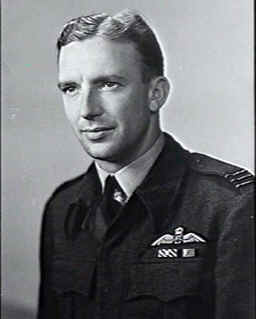
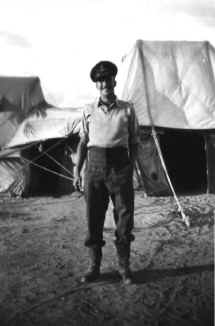
Second Photo sent in by Colleen Bowker and Family
Preferred to fly AM474
| Date of birth | 1917-07-15 | |
| Date and unit at enlistment (ORs) | 1940-10-07 | No 2 Initial Training School. |
| Other units | 1941 | No 6 Elementary Flying Training School. |
| Other units | 1941 | Service Flying Training School. |
| Other | 1941-06 | Left Australia. |
| Other units | 1941-07 | No 7 Operational Training Unit. |
| Other units | 1941-07 | No 112 Squadron. |
| Date promoted | 1941-12-03 | Flying officer. |
| Other units | 1942-02 | No 450 Squadron. |
| Other units | 1942-09 | RAF Station El Ballah. |
| Other units | 1943-04 | No 450 Squadron. |
| Date promoted | 1943-06-03 | Flight lieutenant. |
| Date promoted | 1943-12-06 | Acting squadron leader. |
| Other units | 1943-12-06 | Commanding Officer No 450 Squadron. |
| Other units | 1944 | No 2 Operational Training Unit. |
| Other units | 1944-05 | No 15 Sector, 83 Group, RAAF. |
| Other | 1946-05-07 | Appointment terminated. |
Eric Cowley ( Danny) Saville, 103255V, SAAF,
112 & 260Sqn; KIA 19/09/1943, victories 3,RAF, 5 SAAF Capt , 15 August 1942 to 17 May 1943, 'A' Flt Cdr; DSO, DFC+bar, V x 3, 2 probable, 3 damagedLondon Gazette issue 35813, 4 December 1942, page 1 of 6
Bar to Distinguished Flying Cross.
Captain Eric Cowley-SAVILLE, -D.F
.. (P.IO3255), South African Air Force, No. 112 Squadron. Oneday in October,. 1942, this officer led a formation of fighter aircraft on an interception patrol. A number of
Messerschmitt jogs was observed and engaged after a short .pursuit. During the combat, Captain Saville destroyed
2 enemy aircraft. Subsequently, he skillfully led his formation to base where, in spite of difficulties a perfect landing
was effected. This officer has invariably displayed outstanding leadership, great courage and devotion to duty. Since
being awarded the Distinguished Flying Cross he has destroyed at least 3 enemy aircraft.
Leslie Sawyer RAF Ground Crew Member and Artist
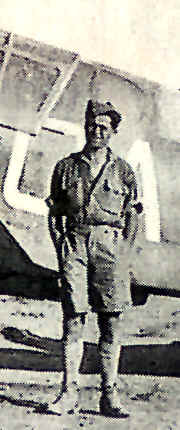
Leslie Clarence Sawyer
Special to The Globe and Mail
May 19, 2007
The Canadian notes were made for Thomas de la Rue - which is still a huge
maker of banknotes and stamps today - as part of a contract with the Bank of
Canada. Mr. Sawyer spent almost his entire working career at Thomas de la Rue,
where the first Canadian note he worked on was a new $5 bill in the 1950s.
There have been six issues of Canadian currency since the Bank of Canada
took charge of all banknote production in 1934. Until then, the government and
the chartered banks both issued notes. Mr. Sawyer had a part in the design of
the fourth series, which was issued from 1969 to 1979 and nicknamed the
multicoloured series by collectors.
"He was a fine artist, working on scenes on the back of the
banknotes," said Mark Crickett of Thomas de la Rue, which describes
itself as the world's largest commercial banknote printer. "The actual
design and production of banknotes is very much a team effort. He was involved
in that series of notes that was designed back in the 1960s."
The previous series of notes was issued in 1954, and it was the first to
show Elizabeth as Queen. (As Princess Elizabeth, her face was on the 1935 $20
bill, as it is today.)
The reason for the switch in 1969 was an increase in counterfeiting. The
bills were different colours for each denomination, but the new design put
bold colours into all the bills except the $1 bill, which remained green with
black ink. The coat of arms was multicoloured, making it hard to copy.
The Queen's hair was designed to be wavy, also making counterfeiting
harder. Although the Queen's portrait was to be on all denominations from the
$1 through to the $100, the finance minister of the day, Edgar Benson,
demanded the portraits of Canadian prime ministers also be used "to
reinforce Canada's burgeoning identity," according to a Bank of Canada
history of banknotes.
The Queen was on the $1, $2, and $20 bills with four prime ministers -
Laurier, Macdonald, Mackenzie King and Borden - on the others. Although the
design for that series was done in Britain, the printing was done in Ottawa.
The project took many years. When Thomas de la Rue moved its headquarters
to Reading, on the other side of London, Mr. Sawyer worked from home.
"I remember when we visited him in the early 1970s, he was working on
the $50 bill," said his daughter, Valerie, who lives in Montreal.
Leslie Sawyer was born in Epsom, a suburb of London. His father was a
carpenter and the family grew up in nearby Sutton. Young Leslie showed a
talent for drawing. Like most British children of the time who were not headed
for university, he finished school at 14 and was apprenticed to a commercial
artist.
The war interrupted his apprenticeship and he joined the Royal Air
Force, working as ground crew. He was stationed in North Africa for a while
and the RAF enlisted his artistic talents to paint fierce-looking shark teeth
on the noses of Kittyhawk fighter aircraft.
Along with banknotes, he designed stamps for the United Nations and many
different countries, including New Zealand, Jamaica and Gibraltar. His title
was security artist, a job held by very few people - perhaps only 40 around
the world at the time. Because of the danger of counterfeiting, the work of a
printer such as Thomas de la Rue has to be secret. His name never appeared on
any of his work.
When he wasn't designing currency, Mr. Sawyer was busy painting, especially
in miniature, since he'd learned to do exacting detail work in currencies and
stamps. "He never stopped drawing. Someone gave him a miniature portrait
done on a piece of ivory, and asked him to restore it. He did it and that
started him painting in miniature on ivory," his daughter said.
Because trading in ivory is illegal, Mrs. Sawyer would go to antique stores
looking for old pieces of ivory on hair brushes and other items. Then Mr.
Sawyer hit upon old ivory piano keys, which were plentiful and relatively
cheap. He did a miniature portrait of Prince Charles on one key, which is in
the Queen's collection. In 1981, he became a member of the Royal Society of
Miniature Painters, Sculptors and Gravers.
Mr. Sawyer retired in 1983 when he was 62 after trouble with his eyesight
making it difficult for him to work. He and his wife moved to Canada to be
with Valerie, who had lived in Montreal with her husband and two children
since the early 1970s. They settled in Beaconsfield, Que.
He returned to England in 1990 to deal with some health problems, which his
wife thought might be due to the cold winters. He came back to Canada for good
in 2002.
LESLIE SAWYER
Leslie Clarence Sawyer was born Jan. 6, 1921, at Epsom, England. He died in
Montreal on April 15, 2007, of congestive heart failure; he was 86. He leaves
his wife, Rose, and daughters Valerie and Barbara.
Wing Commander Lloyd Gilbert 'Algy' Schwab DFC, RAF no. 37831
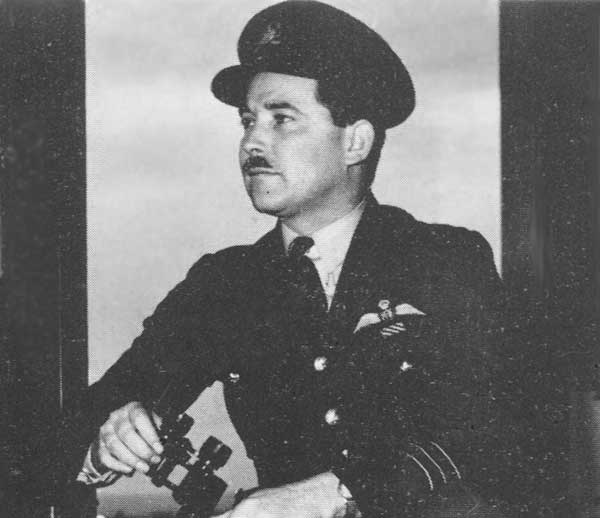
Born in Niagara Falls, 22 January 1915; educated there, joined
RAF in March 1936
Appointed Acting Pilot Officer - on Probation, RAF, 4 May 1936
No.112 Sq. 23 July '40 to 26 June '41, Operations Room, Helipolis, June 1941, to
UK,
October 1941;
Flying Instructor, Central Flying School, also instructed in Canada, returned to
Canada
briefly in 1944
Remained in RAF until 1958 - retired as Wing Commander
SCHWAB, F/L Lloyd Gilbert (37831) - ( SCHWAB, Lloyd Gilbert, S/L, DFC (37831) -
Distinguished Flying Cross (Greece) - awarded as per London Gazette dated 29 December 1942.)
Distinguished Flying Cross - awarded as per London Gazette dated 11 July 1941. Born in Niagara Falls,
22 January 1915; educated there. Appointed Acting Pilot Officer on Probation, RAF, 4 May 1936; with
No.112 Squadron, 23 July 1940 to 26 June 1941; Operations Room, Helipolis, June 1941; to UK,
October 1941; Flying Instructor, Central Flying School; also instructed in Canada; returned to Canada 1944.
Specifically listed in AFRO 1292/41 dated 7 November 1941 as a Canadian in the RAF who had been decorated
as
of that date. Air Ministry Bulletin
4420 refers.
SCHWAB, S/L Lloyd Gilbert (37831) - Distinguished Flying Cross (Greece) -
awarded as per London Gazette dated 29 December 1942.Served with 80 & 112 Sqn 6 victories London Gazette
issue 35217, 11 July 1941, page 9 of 60
Victories :
17 aug 1940 one
S-79 destroyed
31 oct 1940 two CR-42s destroyed
18 nov 1940 one S-79
destroyed
20 feb 1941 one G-50
destroyed
26 mar 1941 one G-50
probably destroyed
13 apr 1941 one G-50
destroyed
All with 112 Sq. while flying Gladiators in Mediterranean theater
Squadron Leader John Evelyn Scoular DFC, RAF no. 37756,

When returning from
France he instructed at 6 OTU from 24 June 1940 as a Flight Lieutenant.
In July he was awarded a DFC for his success in France.
He was then posted to the Middle East, where he took command of RAF 112 Sqn 'K' Flight when it was formed in
November with Gladiators.
13 February. On 22 February 1941 ‘K’ flight saw its first action since its return to operations when Scoular on an
early patrol over Mersa Taclai in Gladiator N5828 saw some Blenheims passing and escorted these to Massawa.
There he spotted a lone S.79 in flight, and shot it down. There is no Italian record of this loss and it may in fact have
been a transport
Savoia.
he was promoted Squadron Leader to command. He was to lead the unit in the Western Desert during the
Battleaxe and Brevity offensives, where he made
further claims
Click on his name for the link to more information and the source
WING COMMANDER LLOYD GILBERT SCHWAB, D.F.C., of Niagara Fails, Ontario, enlisted in the RAFVR as a pupil pilot prior to the war. He was one of the few Canadians who flew the Gloster Gladiator with No. 112 Squadron in North Africa and in the defence of Greece. The King of the Hellenes conferred the Greek Distinguished Flying Cross on Schwab for his gallantry and devotion to duty. His final score was 11 enemy aircraft destroyed
Cpl.
William "Bill" Searles (1920-2003)
RAF
Searles, William
"Bill".
oh Saturday, December 13, 2003 at the age of eighty-three. Retired professor and former chairman of Math and
Science, Faculty of Ed, McGill University. In 1939-1945 Bill served in the Royal Air Force, first with 74 Squadron
and then with 112 Squadron in the Western Desert. He is survived by his loving wife Louis Searles (Howe), his
children Brian and Lynne (Shaun Medicott), grandchildren Julia and William. "A Ju88 attacked Gambut again on
6th February 1942 and Cpl Searles was hit in the hand by a bomb splinter. Flt Lt Humphreys and Sgt Donkin
scrambled in pursuit but failed to overtake it."
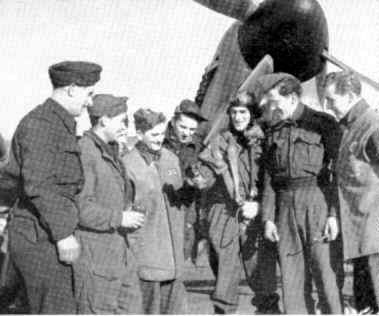
Photo and information is of FL Lt Shaver during his time with 439 Sqn RCAF and is from http://www.rcaf.com/439squadron/TIGER/439Hist_e-112.htm
Sgt LC Shaver, J17058
RCAF from Avonmore, Ontario standing by GA A possibly FL882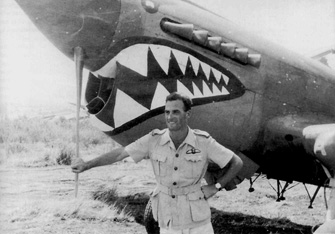
Later in the morning Buldern was attacked again and once more no bombing results could be seen. F/Ls Shaver and
Breck strafed a train, damaging the engine and four cars. On the way home from this sortie the pilots dived down
through a cloud break in an attempt to pinpoint their position. They found themselves on the southern edge of the
Reichswald near Goch, at 400 feet right over the battle area. Light flak immediately opened up with intense and
accurate fire.
The Typhoon flown by F/L L.C. Shaver, the formation leader, was seen to be hit; it flicked on its back and dived into
the ground. A forceful and competent leader, Lyal was regarded as one of the finest pilots in the wing. He had done
his first tour (136 sorties) in North Africa and, since joining No.439 in November, had completed 66 trips over the
lines. Both "A" and "B" Flights had lost their commanders to flak in little more than a week.
Flight Lieutenant Lyell Clarence Shaver
Royal Canadian Air Force
Son of Clarence and Bessie Shaver; husband of Catherine Purcell Shaver, of Toronto, Ontario, Canada, age 26,
died on 02-Mar-1945. With 136 missions on his first tour, and 66 on his second , F/L Lyell Shaver was killed on a
mission into Germany.
The following entry is from 439's War Operations Record Book (Form 540): We lost another Flight Commander,
he is F/L Lyal Shaver, a very forceful character and a competent leader. This loss shook us rigid! Lyal was one of the
finest pilots in the Wing and we all felt so optimistic about him. Being married in Canada before coming over for his
second tour will no doubt cause that additional grief. To date, Lyal has carried out 66 operational sorties,
totalling 80:15 hours on his second tour and gives him a total of 202 sorties, 171:55 operational hours and a grand
total of 839:10 flying hours.
The following entry is from 439's War Operations Record Book (Form 541): After the attack, J/17058 FL Lyell
Shaver and F/L Breck attacked a loco and 15 plus cars, with a claim of 4 cars damaged; considerable light flak was
encountered. On returning to base, the section dived through a break in the cloud down to 400 feet presumably to
pinpoint their position. Intense accurate light flak was encountered and F/L Saver was seen to be hit, flick on his back, dive into the ground and burst into flames in the area E.8546.
Following entry is from The Canadian Virtual War Memorial website courtesy of the Commonwealth War Graves
Commission.
He was flying a Hawker Typhoon, serial MN144 coded 5V-H of the RCAF 439 Squadron
J/17058 FL Lyell Shaver is buried at Cemetery: REICHSWALD FOREST WAR CEMETERY, Germany Grave
Reference: 21. H. 18.
Location: The REICHSWALD FOREST WAR CEMETERY is located 5 km south west of Kleve. From Kleve
the cemetery is located, using the Hoffmannallee from the Town Centre, which becomes the Materbornerallee.
This road enters Reichswald Forest and becomes the Grunewaldstrasse. Follow direction Gennep, entering
Reichswald Forest the cemetery is situated 500 metres on the left. Alternatively from the motorway 57, take exit
Kleve/Goch, which leads onto the 9 N road in the direction towards Kleve. After 3 km turn left on to the 504
direction Kranenburg. Reichswald cemetery is clearly sign posted on the 504 at cross roads Grunewald.
REICHSWALD FOREST WAR CEMETERY is situated on the Grunewald Strasse direction Kleve on the right,
3 km from cross roads Grunewald.lose some informationabout the above cemetery and its location which you may
find of interest.
Sgt Albert "Artie" Shaw, RCAF, 83102
I know one of the guys that flew with 112. Al "Artie" Shaw is a member of my Legion Branch and has helped me
out a few times with Remembrance Day activities for students. A real nice guy. I apologize for not communicating
to you about Artie (he is known by Al to me). I did pass along the website info and he was going to give it to one
of his son’s as he is not that computer literate. I don’t see Al that much lately due to my personal schedule but I
will make an
effort to talk to him and see if I can come up with anything for your website.
Again for your information, we do have a picture of George Wiley hanging in honour with a companion picture
of those who were murdered during the “Great Escape”. Al told me about George when we first hung the picture.
They were friends
Published in the Windsor Star from 8/18/2007 - 8/20/2007.
| Shaw, Albert |
|
||
SHAW, Albert "Al" 87 years. It is with great sadness we
announce the passing of Albert on August 17, 2007. Beloved husband of 62
years to Margaret (Wood). Loving father of Maureen & Silvio Truant,
Rick & Diane, Tom & partner Karen MacDonald, Robert, and
father-in-law to Pat Shaw. Wonderful grandfather to Jim & Christine
Truant, Dana Truant and Marcy Shaw & Kevin Mailhot, Jenna, Jill &
Megan Shaw, Lindsay Shaw & fiance Derek Trepanier, Scott Shaw,
Samantha Brunet & Hannah Derosiers. Papa the Great to Davis &
Benjamin Truant. Dear brother of Bessie Sauve and the late Dora Baker.
After retiring from the 112th Squadron of the R.A.F., Al worked at Hiram
Walker's for 48 years. Always active in the community, Al was president
and a life member of Riverside Minor Hockey Association and an executive
member of the Ontario Minor Hockey Association, the Royal Canadian Legion
Branch 255 and a member of the Military Institute. Visiting at the Walter
D. Kelly Funeral Home and Cremation Centre, 1969 Wyandotte St. E. on
Sunday from 7-9 p.m. and Monday from 2-4 & 7-9 p.m. Funeral Service at
St. Aidan's Anglican Church, 5145 Wyandotte St. E. on Tuesday, August 21,
2007 at 10:00 a.m. Interment at Greenlawn Memorial Gardens. In lieu of
flowers, donations to the Hospice of Windsor or the Canadian Diabetes
Association would be appreciated. A Royal Canadian Legion service will be
held on Monday at 7:30 p.m. under the auspices of R.C.L. Br. #
255.www.mem.com |
|||
HAMILTON SPECTATOR, 1943/04/09
CANADIANS HAVE EDGE ON ENEMY
Flyers From Dominion Mark Up Many Successes Over Africa
Ottawa, April 9, 1943 —(CP)— Canadian flyers are scoring
successes against enemy planes and shipping as they fly on daily operations with
the famous R.A.F. Shark Squadron in the Middle East, the R.C.A.F.'s public
relations officer in the Western Desert —Flight-Lieut. Kenneth MacGillivray—
reported today.
"Flight-Sgt. Albert Shaw, of Riverside, Ont., shared a Messerschmitt 109
with another pilot a few weeks ago," he said. "In recent bombing
attacks Flight-Sgt. John MacAuley, of Scotstown, Que.; Flight-Sgt. Lyall Shaver,
of Avonmore, Ont., and Flight-Sgt. Herbert Snelgrove, of Toronto, scored
possible hits on shipping."
MacAuley's combat score stands at one destroyed and Shaver's at one and
one-half.
Other Canadians in the squadron include FO. John Garn Wright, of Ottawa; PO. Ray
Guest, of Montreal, and Flight-Sgt. Wilfred Brown, of Virden, Man.
Another newspaper clipping of the time reads as follows
Hamilton Airman Plays Part In Aerial Attack on Rommel
(By Ross Munro, Canadian Press War Correspondent) Somewhere
In North Africa, March 4, 1943 —(CP)— Canadian members of R.A.F. squadrons
played a prominent part in the intensive bombing and ground strafing preceding
the fall of Zuara, near the Libya-Tunisia border. Hits were scored on shipping
and important buildings.
Flt.-Sgt. John Macaulay, of Scotstown, Que., scored a direct hit on an axis
tanker he sighted near the harbor mouth at Zuara. The vessel was hit twice by
R.A.F. bombers during the attack.
During the engagement, Flt.-Sgts. Lyell Shaver, of Avonmore, Ont., and Herbert
Snelgrove, of Toronto, made bombing attacks on Rommel's retreating forces. They
added to the confusion in the Nazi ranks by strafing them with cannon and
machine-gun fire.
R.C.A.F. personnel active in the almost ceaseless harassing of the enemy in the
advanced area were PO's John Wright of Ottawa, and C. C. Smith,
of Detroit, and Flt.-Sgt. Albert Shaw, of Riverside, Ontario.
A French-speaking pilot from Montreal spotted a moored Axis seaplane in Pidida
harbor, farther up the coast from Zuara and gave it a rain of fire from his
guns.
Coming in on Rommel's rear-guard installations with guns blazing, one sortie in
which Canadians participated —including Sgt.-Pilot John P. Maloney, 31 Cope
street, Hamilton, Ont., and Sgt. Jack Nichols, of Digby, N.S.— left several
barges and a moored seaplane m sinking condition.
Sgt Stanley Oliver Simpson, 402987, RAAF
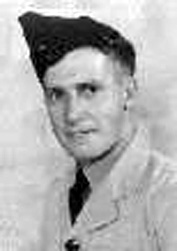
|
Stanley Oliver Simpson enlisted in the Royal Australian Air Force during World War 2 (Service Number 402987) and he was killed in action in Egypt in 1942 when his plane was shot down. The plane wreck & his body were never recovered & he is listed on the El Alamein War Cemetery among those killed with no known grave.
In January 1942 Stanley Oliver Simpson was sent to the Middle East and posted initially to 450 Squadron.
In February 1942 he was posted to 112 Squadron.
In June 1942 he rejoined 450 Squadron and was shot down and killed on 5 July 1942 during an operation to bomb & strafe a German airfield. For more information and events leading up to his death click on the following 450 Squadron link. Service Record link gives access to his service record. The following table indicates a chronological history of his military service and related information as extracted from his RAAF Service Records: |
World War 2 - Military Postings & Locations |
||
Date |
Posting/Location |
Age |
|
11/11/1940 |
Enlisted in RAAF (AC II (P)) |
22 |
|
11/11/1940 |
Transferred from 2RC to 2 Initial Training School at Bradfield Park Lindfield NSW |
|
|
4/01/1941 |
Promoted to LAC |
|
|
9/01/1941 |
Transferred from 2 ITS to 8 Elementary Flying Training School at Narrandera NSW |
23 |
|
6/03/1941 |
Transferred from 8 EFTS to 2 Embarkation Depot at Bradfield Park Lindfield NSW |
|
|
21/03/1941 |
Sailed for Canada. |
|
|
17/04/1941 |
Disembarked at Vancouver Canada. Attached to Royal Canadian Air Force |
|
|
21/04/1941 |
No 1 S Flying Training School at Camp Borden Ontario Canada |
|
|
3/07/1941 |
Promoted to Sergeant |
|
|
4/07/1941 |
Moved from Camp Borden to #1 'M' Depot at Halifax Canada. |
|
|
15/07/1941 |
From #1 MD to RAF TP |
|
|
16/07/1941 |
Sailed for England |
|
|
16/08/1941 |
Posted to 3 Personnel Reception Centre in England |
|
|
23/08/1941 |
Transferred from 3 PRC to 53 Operations Training Unit |
|
|
7/10/1941 |
Transferred from 53 OTU to 123 Squadron |
|
|
21/12/1941 |
Transferred from 123 Squadron to HQ Middle East. |
24 |
|
4/01/1942 |
Promoted to Flight/Sergeant |
|
|
22/01/1942 |
Transferred from RAF ME to ME Pool. |
|
|
23/01/1942 |
Transferred from ME Pool to 450 Squadron. |
|
|
29/01/1942 |
Sgt. S.O. Simpson in Kittyhawk ‘OK-A’, AK603 (Cat.II) ground looped his aircraft on landing, causing damage to the mainplane and undercarriage. |
|
|
18/02/1942 |
Transferred from 450 Squadron to 112 Squadron. |
|
|
7/04/1942 |
Moved to 10 SA Casualty Clearing Station until 21/4/1942 |
|
|
21/04/1942 |
Moved to 63rd General Hospital |
|
|
21/04/1942 |
Transferred from 112 Squadron to HQ RAF ME. Shown as "Non Effective Sick". |
|
|
Duration 3 weeks. |
||
|
2/06/1942 |
Transferred from 112 Squadron to Transit Camp Western Desert. |
|
|
10/06/1942 |
Transferred from TCWD back to 450 Squadron. |
|
|
30/06/1942 |
Sgt. Simpson belly landed his Kittyhawk ‘OK-A’, AK805 at LG 92 after running out of petrol after flying an operation. |
|
|
5/07/1942 |
On the second sortie of the day F/Sgt. Stanley Oliver Simpson and F/Sgt. F.W. Beste were both reported missing. Simpson was K.I.A. and Frank Beste was shot down by ground fire and survived. They were involved in strafing enemy aircraft on the ground at LG 106 (near El Daba). |
24 |
SGT
RONALD
WILLIAM STAVELEY
The following pictures and information is most kindly submitted by Peter Stavely
RONALD WILLIAM STAVELEY, Died on the 18th Sept 1943 aged 21. FLT/SERGEANT,
112 SQUADRON
(Born about 1922)
Given that I have more than a passing interest in Second World War history and that of the RAF in particular, I
became very interested in the sole Staveley fighter pilot and have taken the time to uncover a significant amount of
detail regarding the untimely death of young Ronald Staveley. The following is drawn from a mixture of my own
research and details contained in two books, ‘Shark Squadron Pilot’ by Bert Horden (who I have met and of
whom more later) and ‘Shark Squadron, a history of 112 Squadron’ by Robin Brown. For those readers not
particularly interested in Military aviation history you are quite at liberty to skip this section but I would like to
think you may find it
interesting any way!
In January 2003 I eventually tracked down and met Bert Horden, the biographical author on 112 Squadron’s
operations throughout 1943/4 and who quite amazingly actually joined the squadron in March 1943, on precisely the
same day as Ronald (Sadly I have to report that Bert, who was very kind and helpful to me, later died in December
2003). A couple of days before they joined, the Squadron had suffered what was to be its worst setback at anytime
during the war. On that day in North Africa, the twelve squadron Kittyhawks were ‘jumped’ by a squadron of
ME109’s who attacked out of the sun. Seven British fighters were shot down for the loss of only two German aircraft. Of the seven, one pilot bailed out and made it back to base and two became POW’s – four were killed. One of those captured was Flying
Officer George Wylie who ended up in Stalag Luft III in Poland. Sadly, though infamously, he took part in the
renowned Great Escape (depicted in the book by Paul Brickhill and later in the film with Steve McQueen et al)
and was one of the fifty officers re-captured after the escape and murdered in cold blood by the Gestapo on Hitler’s
orders ‘as
an example to others’.
The 112th Fighter Squadron was operational during 1941/2 in defence of Greece (and briefly in Crete after the retreat from the Greek mainland) and then back to North Africa where it had originally been based. Back in the desert it was most particularly used in
supporting the 8th Army ‘Desert Rats’ of Montgomery at the Battle of El Alamein at the end of October 1942 in one
of the finest victories in the history of the British Army. This was in fact the only land battle won in the whole war
without American support. In 1943 flying the Curtis ‘Kittyhawk’ Mk III in North Africa, (with their famous and
distinctive ‘shark-nose’ design), Ronald Staveley, aged just 21, actually joined the squadron six months after El
Alamein, on 14th March 1943. Amazingly, as I mentioned earlier, another young pilot who joined that day was
Herbert ‘Bert’ Horden, who survived the war and with whom I not only corresponded several times but personally
met at his home. Sadly he died in
December 2003.
For the first two months, 112 squadron was on continuous air support for ground forces in North Africa (Tunisia) and
pushing Rommel’s Afrika Corps. westwards and back out of Africa when they finally surrendered on May 13th.
Ronald was active all this period and on the very final day of the North African campaign he was on a sortie over
Cape Bon on the coast of Tunisia to attack a flak position, when he was hit and forced to pancake land his aircraft
near
Hammamet. He was, however, unhurt and rejoined his squadron the same day!
There followed a brief respite during which King George V1 made an inspection but in the third quarter of the
year they were again in action having moved to an airfield in Malta from where they supported ground troops
during the invasion of Sicily (Operation Husky, July 9th and 10th). After some six weeks of sorties, on the
30th July, Ronald was part of a formation attacking railway marshalling yards at Giordini when he was forced to
crash land his aircraft yet again (maybe hit by flak). He landed near the front line but yet again was unhurt and
returned to his squadron the very next day! Just ten days later on 11th August, Sicily fell to the allies. The next
month involved sundry sorties attacking enemy shipping in the Straits of
Messina and forays over the Italian coast.
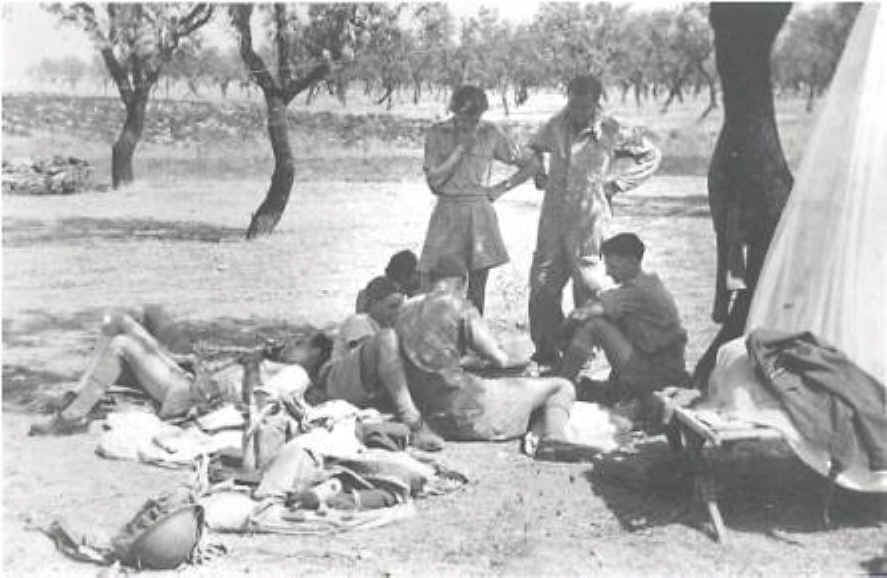
A remarkable photo taken by Bert Horden (and provided by him) of members of 112 Squadron at Grottaglie airfield. showing Ronald Staveley (seated right), Can anyone identify the others?
This
was very likely taken on either the 17th
or 18th September
1943 and hence it must have been either the day he was killed or the previous
one.
The invasion of Italy was less than two months later on 8th/9th September, after the landings by British and American
forces at Taranto and Salerno respectively. Over the next few days the squadron had to uproot from Sicily to Italy
and found itself (from 16th-20th September 1943) at a place called Grottaglie near Taranto on the main road to
Brindisi in the ‘heal’ of Southern Italy. This operation was in fact a bit of interesting wartime military history, being the
first time ever that an operational squadron was supported entirely by air. A whole squadron of DC3’s of the
USAAC flew in food, water, ammo, bombs, glycol, spares and so on for a full week until the ground staff and full
equipment arrived by sea.
It was during this fateful week, on just the second day of operations, the 18th September 1943, that Ronald Staveley
was shot down for the third time and sadly his luck ran out. There were two operations that day, one took off at
11.45am and the other at 4.55pm The first, which lasted for an hour and twenty minutes, was an armed
reconnaissance of the Potenza roads near Vallata and the second was in the same area. Ten enemy motorized
transport vehicles were left burning and 23 damaged, including a tank. It was an hour into this second sortie that
they encountered intense anti aircraft fire at Calabritto and Ronald was hit by flak at 500ft after a strafing run and
seen to crash. He had survived six months of action, been shot down approximately every two months and was
just 21 years old. You can find actual details of the action as reported in two extracts of the Squadron record
books in Appendix 29. In those five days at Grottaglie, the Squadron lost
three pilots shot down and killed.
Unfortunately, I have no knowledge of his pedigree within the Staveley families researched and despite strenuous
efforts and wide ranging enquiries have been unable to find any living relatives. All I know is that his parents were
Henry and Ellen Staveley and that he was born in York (birth records at the Family Record Centre). Records of
Second World War personnel are, as yet, not readily available to the
general public in the National Archives.
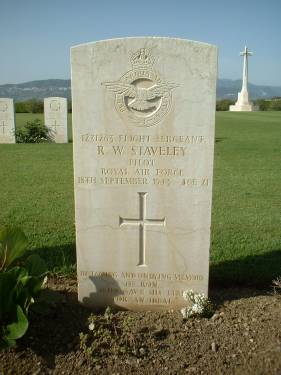
The
Grave of Ronald Staveley in the Commonwealth
War
Graves cemetery at Salerno in Italy which I
photographed
whilst on holiday nearby in May 2003
********************************************************
Flight Lieutenant Denis Herbert Vincent Smith, RAF No. 70631 Pilot Officer Smith joined
112 Squadron on 18 August 1940.He took part in the Greek campaign with this unit.
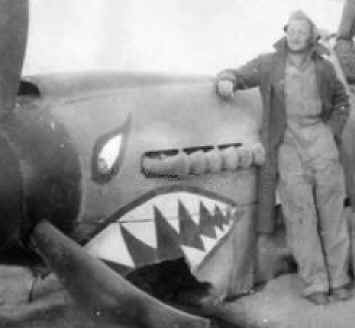
Sgt Randolph Charles Carlyle "Smithy" Smith J16175 RCAF taken on 8/11/1942 by
FR259, GA X
Flying Officer R. H. Smith, RAF no. 36161 16/5/39 to 10/9/40
Photo supplied by Patricia Molloy daughter of J. F. Fraser
SMITH, F/L Robert Rutherford (40952) - Distinguished Flying Cross - No.112 Squadron
Photos contributed by his son Robert Gavin Smith rgavsmith@sympatico.ca
JU87 - Stuka (Captured Aircraft) records indicate he
flew this plane on 24th November 1942 to Martuba No 3
Ref: http://www.airforce.ca/canraf/CANRAF.S-Z.html
SMITH, F/L Robert Rutherford (40952) - Distinguished Flying Cross - No.112 Squadron - awarded as per London
Gazette 23 February 1943. Born in London, Ontario, 17 August 1915; home there; educated there. Applied for
Short Service Commission, 31 August 1937; first medical examination not favorable; examined again, 2 November
1937; tentatively accepted as of 9 April 1938 and ordered to Ottawa for final interviews; these held on 2 May 1938
(G//C Stedman) and he was issued travel warrants to travel on SS Antonia. Sailed from Canada, 6 May 1938.
Pupil Pilot, RAF, 16 May to 8 July 1938; appointed Acting Pilot Officer on Probation, 9 July 1938; confirmed in
appointment as Pilot Officer, 16 May 1939; promoted Flying Officer, 3 September 1940; promoted Flight Lieutenant,
3 September 1941. Trained at No.3 FTS, Hamble and South Cerney. In No.229 Squadron at outbreak of war.
Wounded, 15 September 1940 in action over Kent (bullet through left leg). Flying instructor in England and
South Africa until August 1942 when posted to No.112 Squadron. Shot down in Kittyhawk FR325, 45 miles
northwest of Foumtatouin, 1530 hours,
10 March 1943 (Prisoner of War). Transferred to RCAF with effect from 24 November 1944 (C94080);
repatriated 23 July 1945; released 16 November 1945.
Passed away in his home town of London Ontario,, 17 November 1965 and is buried in Woodland cemetery (see attached clip from London Free Press Nov 18, 1965).
. AFRO 513/43 dated 26 March 1943 (reporting his DFC) and AFRO 809/43 dated 7 May 1943
(reporting him a POW) described him as a Canadian in the RAF. Credited with the following victories: 29 May 1940,
one Bf.109 destroyed; 1 June 1940, one Ju.87 destroyed; 11 September 1940, one He.111 destroyed
(possibly two other victories in 1940); 1 October 1942. one Bf.109 probably destroyed; 22 October 1942,
one Bf.109 destroyed; 31 October 1942, one Ju.87 (Italian Air Force) destroyed; 31 December 1942, one
Bf.109G destroyed plus one MC.202
destroyed.
Flight Lieutenant Smith is a courageous fighter. In October 1942, on his first sortie with the squadron, he shot
down one of four Messerschmitts which were intercepted. Some days later, during a bomber sortie, he
destroyed an Italian aircraft after evading an enemy fighter which had pursued him. In December 1942,
Flight Lieutenant Smith destroyed two enemy aircraft on one sortie, bringing his total victories to eight. He
has displayed great keenness and determination.
NOTE: On a form dated 19 July 1945 he estimated his service at 450 operational hours (150 sorties), 1,000
non-operational hour FLIGHT LIEUTENANT ROBERT RUTHERFORD SMITH, D.F.C., of London, Ontario,
was a member of a group of Canadians who joined the RAFVR as pupil pilots prior to World War 11. He was a
fighter pilot during the Battle of Britain, fought over Dunkirk and in the defence of the British Isles that followed.
Before being shot down and taken prisoner, F/L Smith destroyed 8 enemy aircraft while serving with Nos. 112
and 229 Squadrons.
Following is from http://acesofww2.com/Canada/aces/smith_RR.htm
R.C.A.F. Squadron Helping To Decimate
Fleeing Army of Axis on African Front
So Many Bombers Taking Part, Loads Released in Shifts
on Foe
Cairo, November 5, 1942 - (CP Cable) - Endless relays of Canadian aerial
scrappers joined in mass formations of
allied airmen and pounded relentlessly at axis forces fleeing in disorder on the Egyptian desert before the victorious
British 8th army. Flt.-Sgt. C.L. Shaver, of Cornwall, Ont., said there were "so many bombers operating we were
dropping our loads in shifts."
"On our third trip of the day we had to wait until other bombers had
completed their work before we could make a
run at the target," he said.
Similar stories were told by other Canadians who described the aerial onslaught
on the tattered forces of Field
Marshal Erwin Rommel as an amazing sight."
The condition of one road along which the axis soldiers were fleeing was a
"shambles," said Flt.-Lt. R.R. Smith,
of London, Ont.
These airmen are members of the R.A.F. One complete Royal Canadian Air Force
squadron also is operating on
the desert front.
The famous desert "Shark" squadron of fighter-bombers has played a
brilliant role since the offensive started.
The squadron includes many Canadians who have engaged in bombing axis landing grounds and transports and
fought
hundreds of dog-fights.
Inflict Heavy Losses
During one 48-hour period the squadron destroyed 13 axis planes and suffered in
exchange only two wounded pilots.
During recent heavy fighting R.C.A.F. members of the squadron, accounted for at
least eight Stukas and one ME-109. Flt.-Sgt. Brown of Virden, Man., destroyed
two Stukas, while Flt.-Sgt. Dick DeBourk of Boston, Mass., also knocked off a
pair.
Sgt. R.C.C. Smith, of Windsor, Ont., bagged one Stuka and also got credit for a
probable. P.O. Joe Crichton,
of Chapleau, Ont., destroyed a Stuka and P.O. L.H.
Curphey, of Ottawa, got the Messerschmitt.
Most of the dive-bombers were destroyed when the squadron intercepted a
formation of 30 escorted by 15
Messerschmitt fighters. The allies tore in and forced the Germans to jettison their bomb cargoes over their own lines.
_________________________________________________
|
Born in London, Ontario, 17 August 1915; NOTE: On a form dated 19 July 1945 Died in London Ontario, 17 November 1965. AFRO 513/43 dated 26 March 1943 (reporting his DFC) & |
_________________________________________________
Canadian Fliers Played Leading Role in Desert
Ottawa, November 26, 1942 - (CP) - Men of the R.C.A.F., flying with the R.A.F.’s famous Shark Squadron in the
British offensive which routed Rommel's Africa Corps, "accounted for" nine enemy planes in two days, R.C.A.F.
headquarters said today.
The squadron's total bag in that period at the start of the 8th Army's westward
surge was thirteen enemy aircraft.
The activities of the Canadian airmen - one and perhaps two of them citizens of
the United States - were cited as an
instance of the leading part R.C.A.F.
fliers are playing in the current African operations.
These are the R.C.A.F, men flying fighter-bombers with the Shark Squadron,
oldest air force unit in point of service
on the desert front, who accounted for
the Nazi machines:
Flight Sergeant W. D. Brown, Virden, Man., two Stukas destroyed.
Flight Sergeant Dick DeBourke, Boston, two Stukas destroyed, one probably
destroyed.
Flight Sergeant, R.C.C. Smith, Windsor and Detroit, one Stuka confirmed, one
probable.
Pilot Officer L.H. Curphey, Ottawa, one plane destroyed.
Flying Officer Joe Crichton, Chapleau, Ont., one plane destroyed.
The basis for the Air Force statement was a report from an R.C.A.F. public
relations officer with the Canadians in
the Middle East. The statement said Canadian airmen were "well to the fore" and "accounted for eight Stukas and
one Messerschmitt 109.
While the statement did not list a Messerschmitt specifically in the bag of the
Canadians named, an Air Force
spokesman said possibly Curphey or Crichton got
it.
The Shark Squadron gets its name from the jagged shark’s teeth painted on the
noses of its aircraft, which became
the "nemesis of the Germans both in the
air and on the land."
"One of the great battles (of' the squadron) was on a day when they
encountered a group of thirty Stukas with an
escort of fifteen ME 109's,"
the R.C.A.F. officer said in his report.
"This was while they were returning to base after bombing an enemy
airfield. Out numbered as they were they did
not hesitate. They tore into the Germans with such speed that they forced the Nazi dive bombers to jettison their
cargoes of bombs on their own trooplines.”
Mass formations of aircraft roared through the skies carrying tons of
destruction in the early stages of the offensive,
the report said, comparing the air traffic in some sectors to rush hour at the corner of King and Yonge Streets in
Toronto.
It quoted Flight Lieutenant C.L. Shaver of Cornwall as saying; "There were
so many bombers operating that we were
dropping our loads in shifts. On our third trip we had to wait around until other bombers had completed their
bombing
before we could make a run at the target."
Flight Lieutenant R.R. Smith of London, Ont., who was on his second tour of
operations after a layoff, described
conditions in some enemy sectors as a "shambles."
_________________________________________________
SMITH, F/L Robert Rutherford (40952) - Distinguished Flying
Cross - No.112 Squadron
Awarded as per London Gazette 23 February 1943.
Flight Lieutenant Smith is a courageous fighter. In October 1942, on his first sortie with the squadron, he shot down
one of four Messerschmitts which were intercepted. Some days later, during a bomber sortie, he destroyed an Italian
aircraft after evading an enemy fighter which had pursued him. In December 1942, Flight Lieutenant Smith destroyed
two enemy aircraft on one sortie, bringing his total victories to eight. He has displayed great keenness and
determination.
________________________________________________
|
Credited with the following victories: 29 May 1940,
one Bf.109 destroyed; |
_________________________________________________
Ex-RAF Ace Bob Smith Dies, Age 50
Robert R. (Bob) Smith, 50, of 324 Belfield Rd., an ace Battle of Britain fighter pilot, credited with destroying eight
enemy aircraft and
winner of the Distinguished Flying Cross, died yesterday in Westminster
Hospital.
A native of London, Mr. Smith was a member of a small group of Canadians who
joined the RAF early in the Second
World War.
He fought over Dunkirk and in the desperate defense of the British Isles which
followed
He was taken prisoner later while serving in North Africa.
He retired two years ago from the federal department of agriculture
He is survived by his wife, the former Betty Thomas; a son, Robert Gavin; two
daughters, Sharon Lianne and Barbara
Joanne, all at home; and his mother, Mrs.
Cathleen Smith, of London.
Funeral service will be held Saturday with the Rev. David G.L. Rees, Church of
the Redeemer, officiating at the
George Logan and Sons funeral home. Cremation at Woodland Crematorium with burial in Woodland cemetery.
Following From:
http://www.airforce.ca/canraf/CANRAF.S-Z.htmlSMITH,
F/L Robert Rutherford (40952) - Distinguished Flying Cross - No.112
Squadron - awarded as per London Gazette 23 February 1943.
Born in London, Ontario, 17 August 1915; home there; educated there.
Applied for Short Service Commission, 31 August 1937; first medical
examination not favourable; examined again, 2 November 1937; tentatively
accepted as of 9 April 1938 and ordered to Ottawa for final interviews; these
held on 2 May 1938 (G//C Stedman) and he was issued travel warrants to travel on
SS Antonia. Sailed from
Canada, 6 May 1938. Pupil Pilot, RAF, 16 May to 8 July 1938; appointed Acting
Pilot Officer on Probation, 9 July 1938; confirmed in appointment as Pilot
Officer, 16 May 1939; promoted Flying Officer, 3 September 1940; promoted Flight
Lieutenant, 3 September 1941. Trained at No.3 FTS, Hamble and South Cerney. In
No.229 Squadron at outbreak of war. Wounded, 15 September 1940 in action over
Kent (bullet through left leg). Flying instructor in England and South Africa
until August 1942 when posted to No.112 Squadron.
Shot down in Kittyhawk FR325, 45 miles northwest of Foumtatouin, 1530
hours, 10 March 1943 (Prisoner of War). Transferred
to RCAF with effect from 24 November 1944 (C94080); repatriated 23 July 1945;
released 16 November 1945. Died in
Montreal, 17 November 1965. AFRO
513/43 dated 26 March 1943 (reporting his DFC) and AFRO 809/43 dated 7 May 1943
(reporting him a POW) described him as a Canadian in the RAF. Credited with the
following victories: 29 May 1940,
one Bf.109 destroyed; 1 June 1940, one Ju.87 destroyed; 11 September
1940, one He.111 destroyed (possibly two other victories in 1940); 1
October 1942. one Bf.109 probably destroyed; 22 October 1942, one
Bf.109 destroyed; 31 October 1942, one Ju.87 (Italian Air Force)
destroyed; 31 December 1942, one Bf.109G destroyed plus one MC.202
destroyed.
Flight
Lieutenant Smith is a courageous
fighter. In October 1942, on his first sortie with the squadron, he shot down
one of four Messerschmitts which were intercepted.
Some days later, during a bomber sortie, he destroyed an Italian aircraft
after evading an enemy fighter which had pursued him.
In December 1942, Flight Lieutenant Smith destroyed two enemy aircraft on
one sortie, bringing his total victories to eight.
He has displayed great keenness and determination.
NOTE:
On a form dated 19 July 1945 he estimated his service at 450 operational hours
(150 sorties), 1,000 non-operational hours.
Pilot
Officer Geoffrey Buxton Smither
,
Training in Toronto, Ontario
St. Catherines, Dunnville, Ontario and Aston Down, England
Prior Operational Experience with RAF 124 Squadron ETO for 9 weeks
He was posted in just 7 days after Wilfred David ("Western Desert" or "Canada") Brown
After his tour with RAF 112 squadron, he then went on to 73OTU near Cairo until the wars end.
Worked for Canadian General Electric until his retirement and passed away about 10 yrs. ago
(Information from his nephew John)

S/Ldr Somerville, C/O 112 squadron at Helwan 1939, Helwan was outside of Cairo
Air Commodore Duncan M
acDonald "Slim" Somerville32113, RAF, 16 May 1939 to 29 September 1940 CO
Brother
to Flying Officer (Pilot) JAMES ALEXANDER BROWNLIE ( Young Hamish, as he was
known by the family) SOMERVILLE, 90196, Royal Air
Force (Auxiliary Air Force), KIFA, ( killed in Spitfire I L1047, which had L1059 land on it at
night while with 603 Sqdn at Grangemouth on this date. The pilot of L1047 was
killed in this accident. Scotland's people certainly has the death of James Alexander
Brownlie Somerville
(age 26) registered in Grangemouth, Stirling in 1939) 01/10/1939, 603
(City of Edinburgh) Sqdn, .......from his nephew, whose father, Bill, did set
down the family history as far as he knew personally. 'Hamish was killed as a
Flying Officer.... After shooting down a German bomber over the North Sea he had
just landed on the airfield when another fighter landed on top of him and
decapitated him'.....from Peter Connon, the collision happened at newly opened
RAF Grangemouth (now covered by the BP oil refinery) and the other aircraft was
a Spitfire of 609 Squadron based at RAF Catterick, Yorkshire. (Henk Welting
sends this in, Just a minor
comment: Air Britain records that Spitfire L1058 crushed L1047 at Grangemouth;
L1059: Dived into ground near Slamannan, Stirlingshire 14.2.41.)..... but as
Paul McMillan points out in a recent e-mail to me, L1058, First Flown
14-7-39; 27 MU 22-7-39; 603 Sqn 6-9-39; Damaged by Bf 110 and failed to return
from patrol off Dunkerque 1-6-40 (F/O IBN RUSSELL killed); SOC 8-6-40
L1059, First Flown 14-7-39; 27 MU 22-7-39; 603 Sqn 16-9-39; crashed on to L1047
whilst landing Grangemouth 1-10-39; AST 30-11-39; 266 Sqdn 4-6-40; struck
building landing Wittering C2 Sgt Eade safe 9-8-40; 1 CRU 17-10-40; 58 OTU
29-1-41; dived into ground and burnt out near Slamannan Stirlingshire dbf
14-2-41; SOC 21-2-41
So from the Sqdn use I cannot see how it can be L1058 - I think it is an Air
Britain typo...
Both
Aircraft have subsequent History to the accident on 1-10-39. Therefore I WOULD
IMAGINE Somerville COULD HAVE BEEN killed by the prop of the other aircraft...
So while his aircraft was destroyed, the other aircraft COULD have only have
shock damage and was not seriously damaged
(though this is just a theory I HAVE NO PROOF) that
the other aircraft would only have shock damage... To add to the story, the
following brief obituary appears in The Times on Monday, Oct 09, 1939
"Fallen Officers
The Royal Air Force
Flying Officer James Alexander Brownlie Somerville, killed on active
service, was commissioned as a Pilot Officer in the Auxiliary Air
Force on February 12, 1937. He was promoted to Flying Officer on
August 14, 1938"
Paul McMillan
Henk
Welting's follow up e-mail: Agree Paul that it must have been L1059 that landed
on L1047; must be
a typo in AB-Serials L1000-N9999 (latest edition). Will update my files.
Son of Doctor James Alexander and Ann MacDonald Somerville; husband of Margaret Somerville, of Conon Bridge, Ross and Cromarty
Brother to W (Bill) Somerville: Lieutenant-Colonel W (Bill) Somerville, born 4/8/1909, Lupton House 1924-1927; Army Class, Head of House, School Prefect, 1st XV and First XI; RMC Sandhurst; in 1929 serving with 1st Royal Fusiliers A distinguished regular soldier, he was commissioned into the 3rd Gurkhas in 1930. Because of his experience of mountain warfare on NW Frontier, Somerville was specially selected for the Norway Expedition in 1940 where he won the MC. Later, as a Brigade Major in 17th Indian Division in the early battles of the Burma campaign, he was cut off on the wrong side of the Sittang Bridge when it was blown prematurely. He swam the 500 yard wide Sittang under fire. He was paid the very unusual compliment, as a relatively junior officer, of being mentioned in the dispatch of the GOC 17th Indian Division. He went on to command the 2nd/3rd Gurkhas in Italy, winning a DSO at Monte Castello in August 1944 when his men counter-attacked a strong German incursion, using their kukris in hand-to-hand battle. The GOC10th Indian Division wrote to Bill Somerville, It was a very tough proposition and you handled your Battalion magnificently
Duncan MacDonald b
: 30 Nov 1910 r: 28 Dec 1957 d: xx xxx xxxxMentioned in SEDBERGH SCHOOL WAR HONOURS 1939-45,
His previous school was Alton Burn, Nairn.. He attended Lupton House from 1924-1929 where he was a School Prefect and played in the First XI for two years. He was Head of his House, Lupton and (senior) Under Officer in the OTC.
The cricket criticisms which might amuse:
1928 'Hung onto the edge of the XI till the very end of the season but amply justified his eventual inclusion by some sterling batting against Stonyhurst . Has much to learn yet but has the right temperament.'
1929 'After a lamentable start, recovered and surpassed his recent form and played one or two admirable innings
OBE
- 1 Jan 1946, MiD - 1 Jan 1943.
Plt Off (P): 9 Oct 1931, Plt Off: 9 Oct 1932, Fg Off: 9 Apr 1933, Flt Lt: 9 Apr 1936, Sqn Ldr: 1 Dec 1938, (T) Wg Cdr: 1 Mar 1941, Act Gp Capt: 1 Jun 1942?, Wg Cdr (WS): 1 Dec 1942, Wg Cdr: 1 Oct 1946, Gp Capt: 1 Jul 1949, Act A/Cdre: 1 Jun 1955?, A/Cdre: Retained.
29 Oct 1931: U/T Pilot, No 3 FTS.
18 Sep 1932: Pilot, No 4 Sqn.
1 Jan 1935: Staff, RAF Farnborough.
13 Jul 1936: QFI, No 8 FTS.
21 Apr 1938: Flying Examining Officer, HQ No 26 (Training) Group.
5 Dec 1938: CFI?, No 2 Air Armament School
16 May 1939: Officer Commanding, No 112 Sqdn.
15 March 1940 Forced to bale out when his plane mysteriously caught fire, pilot hospitalized with burns, Some months before Italy declared war, S/L ‘Slim’ Somerville was up in his Gladiator carrying out an aerobatic display, when suddenly in the middle of a slow roll, dead over the aerodrome, a spurt of flame and smoke burst from the cockpit. The roll was completed and the C.O. took to his parachute, making a successful landing a few miles from the aerodrome but unfortunately his face and hands were badly burnt before he could get out of his aircraft. However, the ambulance and ‘pick-up’ were racing across what appeared to be a mile of flat sand waste to where the C.O. was about to land. The Ford ‘pick-up’ had outstripped the slower ambulance, when they shot straight into a wadi with a sheer bank of sand 15 feet below, but apart from scratches and bruises and a dent in the roof and bonnet of the car, no damage was done and the car was pushed onto its wheels, started up and even so arrived first on the scene to help the C.O. From March of the Gladiators by J.F. Fraser
29 Sep 1940:
1944 Staff, HQ No 8 (Pathfinder Force) Group.
xx Aug 1945: Officer Commanding, RAF Gatow.
xx Jul 1947:
21 Sep 1948: SASO, No 66 (Scottish) Group.
11 Jun 1951:
1 Jun 1955: Director of Flight Safety.
A fellow member of his course was Geoffrey Quill, who would make a name for himself after leaving the RAF as a test pilot with Supermarine, carrying out much of the test work on the Spitfire.
In May 1939, he was posted to the Middle East and whilst sailing to Egypt, was tasked with the formation of No 112 Squadron. Equipped with Gladiators, the squadron saw little activity until it was sent to the Sudan in June 1940.
Whilst serving at HQ No 8 Group, he occasionally acted as a 'Master Bomber'.
Flying Officer Peter Edward Campbell. Strahan, RAF no. 36154 On 16 May 1939
Photo supplied by Patricia Molloy daughter of J. F. Fraser
Peter Strahan was posted to 112 Squadron when this unit was formed aboard HMS Argus in Portsmouth, Hampshire.112 Squadron was sent to Egypt and arrived on 25 May 1939.When Italy declared war on 10 June 1940 he served as Pilot Officer in ‘A’ Flight Strahan left 112 Squadron on 24 September 1940. Strahan ended the war with 1 biplane victory, this one being claimed while flying Gloster Gladiators
Flt Sgt Norman Ernest Swinton (Austrailian). 401457
| Service Record | |
|---|---|
| Name | SWINTON, NORMAN ERNEST |
| Service | Royal Australian Air Force |
| Service Number | 401547 |
| Date of Birth | 23 Apr 1918 |
| Place of Birth | WARRNAMBOOL, VIC |
| Date of Enlistment | 28 Feb 1941 |
| Locality on Enlistment | Unknown |
| Place of Enlistment | MELBOURNE, VIC |
| Next of Kin | SWINTON, J |
| Date of Discharge | 28 Sep 1945 |
| Rank | Flying Officer |
| Posting at Discharge | 2 OPERATIONAL TRAINING UNIT |
| WW2 Honours and Gallantry | None for display |
| Prisoner of War | No |
